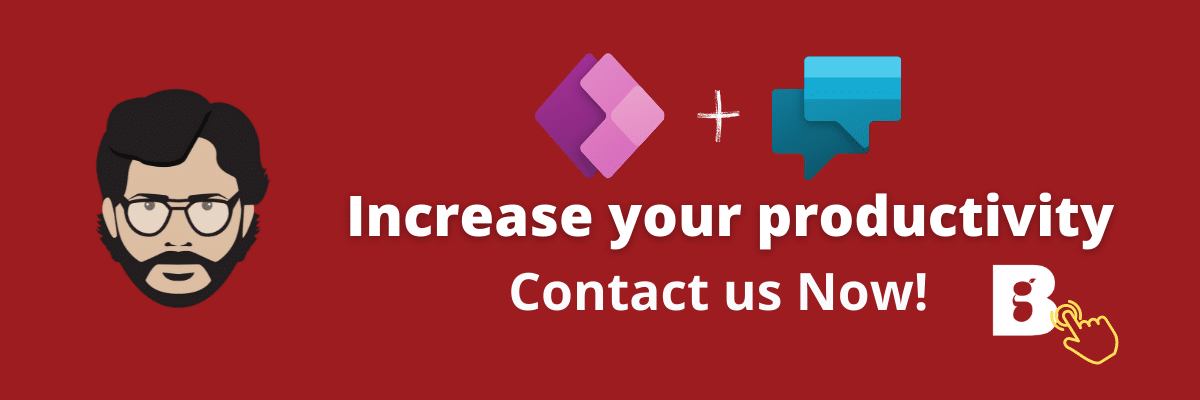Microsoft are constantly trying to make Teams better. One recent example is the new Power Apps integration in Teams. The goal is to increase productivity with Power Apps, by giving users speedier access to extra tools.
The Teams Power Apps integrations were first announced last year. If you haven’t yet used the Power Apps integration in Microsoft Teams, we would definitely recommend trying it. Let’s see why.
What is the Microsoft Teams integration with Power Apps?
Microsoft Teams is a communication and collaboration platform where people can easily chat with coworkers. Power Apps is a part of the Microsoft Power Platform, and it lets people build low- or no-code business applications. Thanks to the integration, you can now install pre-existing Power Apps in Teams, or build your own Power Apps from within the Teams interface.
The purpose of this integration is to increase productivity with Power Apps. Since more workers are spending more of their time in Microsoft Teams, this integration puts Power Apps at people’s fingertips.
Learn more: 5 benefits of Power Apps for 2021
How does the Microsoft Teams integration with Power Apps work?
The Power Apps integration with Microsoft Teams means that you can now build a canvas or model driven app from right within Microsoft Teams. You simply need to install the Power Apps app in Teams and you will be able to use all the features of Power Apps. You then build apps just as you would build them in the ‘traditional’ Power Apps tool.
Alternatively, if you have already built a Power App, adding it into Microsoft Teams is very straightforward. If you want to add a personal app, it takes just five simple steps:
- Log into your Power Apps account to find the app you want to embed in Teams
- Once you find the app, select the more actions icon (…) and click on ‘Add to Teams’
- You will then need to download the app
- Next, you open Teams and upload the app directly by selecting ‘apps’ in the Teams interface and ‘Upload a Custom App’
- You need to add the personal app to a Team, and then simply publish it
You can also quickly embed canvas apps and model driven apps as tab apps. Check out Microsoft’s guides to doing this here.
Benefits of Microsoft Teams integration with Power Apps
As Power Apps experts, we believe that this integration with Microsoft Teams could provide some serious benefits for businesses.
At the moment, most companies publish their Power Apps on the company intranet or in places like SharePoint Online. If an employee wants to use the application, they must go to the place it is stored to use it. For example, if you wanted to use a leave request app, you would need to navigate to your SharePoint HR page and use the widget.
The problem with this approach has always been that it requires people navigate to the place the app was published. But this relies on employees:
a. Knowing that the application exists
b. Knowing which intranet page it is held on
c. Remembering to visit that page if they need to perform one task or another
However, the Microsoft Teams integration with Power Apps means apps can be attached to specific channels or projects, and used from within Teams. So, what are the benefits?
Avoids breaking the flow of work
Isn’t it annoying when you have to stop the work you were doing to fill in a form? If people spend most of their days in Microsoft Teams but have to open up the intranet and seek out your Power Apps, it breaks their flow of work. On the other hand, if they can access the app after a couple of clicks from their main Teams channel, they can use it quickly then get on with their day.
Improves ROI on Power Apps you’ve built
Although Power Apps are inexpensive to build, you still need to pay for Power Apps licenses and think about the time it took to create the app. It would therefore be a shame if people were underutilizing it because they didn’t know it existed or couldn’t remember how to find it. The Power Apps integrations with Microsoft Teams means people are much more likely to find and use the app, boosting your ROI.
Easier to collaborate when building apps
Because you can now build Power Apps right within Microsoft Teams, it is much easier for coworkers to collaborate on the design and layout of the app. It’s even possible for them to view the app being built on the canvas and make comments or suggestions about the app logic. This means the app will be much more useful first time.
By integrating with Teams, you can really expect to increase productivity with Power Apps. You will use the apps you’ve built more often, and find it easier to create new apps too.
Ready to increase productivity with Power Apps?
The Microsoft Teams integration with Power Apps makes so much sense. Since more and more people are using Microsoft Teams as the main place they work, this integration will make it much easier to increase productivity with Power Apps.
As Teams and Power Apps experts, we are so excited about the potential of this integration. We see the benefits every day – thanks to this integration, many of our customers are using their preexisting apps more intensively and building brand new apps from right within Microsoft Teams.
To get started, you can begin publishing some sample Power Apps from the Teams store and try it for yourself. Or for more specific support, our Power Apps experts can help you begin using this integration.






